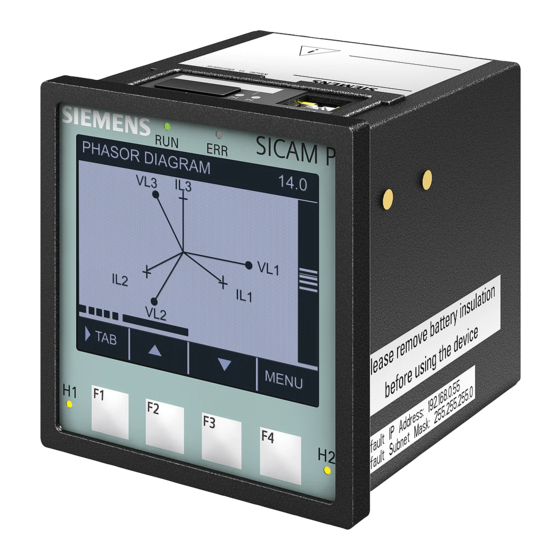Table of Contents
Advertisement
Quick Links
Power Monitoring Device
and
Power Quality Recorder
SICAM P850/P855
7KG85xx
V2.60
Device Manual
E50417-H1040-C482-A6
Preface
Open Source Software
Contents
User Information
Overview
Device Design
Measurands and Recording
Getting Started
Connection Principle
Operation at Use of a PC
Operation at Use of the Display
Time Synchronization
Calibration
Maintenance, Storage, Transport
Failures and LED Indications
Technical Data
Operational Indications
Operating Parameters
Glossary
Index
1
2
3
4
5
6
7
8
9
10
11
12
13
14
15
Advertisement
Table of Contents

Summarization of Contents
Preface
Purpose of this Manual
Describes the manual's scope and content.
Target Group
Identifies the intended audience for the manual.
Scope of Validity of this Manual
Specifies the product versions covered.
Further Support
Provides contact information for Siemens support.
Training Courses
Information on available training programs.
Notes On Safety
DANGER
Describes hazards that will cause death or severe injury.
WARNING
Describes hazards that can cause death or severe injury.
CAUTION
Describes hazards that can cause minor or moderate injury.
NOTICE
Describes hazards that can cause property damage.
NOTE
Highlights important product or documentation information.
Statement of Conformity
Further Standards
Lists relevant compliance standards.
1 User Information
Application
Describes the device's use in power monitoring and quality recording.
Measurands
Lists quantities that can be recorded or calculated by the device.
Communication
Details Ethernet and RS485 interfaces for system integration.
Time Synchronization
Explains the need and methods for time synchronization.
Parameterization
Describes how to set device parameters via PC or softkeys.
2 Overview
2.1 Device Versions
Details different models and their features.
2.2 Ordering Information, Scope of Delivery and Accessories
Provides product codes and included items.
3 Device Design
3.1 Mechanical Design
Describes the physical structure and layout.
3.2 Display and Softkeys
Explains the user interface elements on the device.
3.3 Electrical Design
Outlines the internal electrical modules and block diagram.
4 Measurands and Recording
4.1 Measuring and Recording System
Details how the device measures and records data.
4.2 Measurands
Lists all electrical quantities measured and calculated.
4.3 Display of Measurands
Describes how measured values are presented.
5 Getting Started
5.1 Unpacking, Inspecting the Delivery, and Installing the Battery
Initial device handling and setup.
5.2 Assembly
Instructions for mounting the device.
5.3 Electrical Connection
Guidance on wiring the device.
5.4 System Requirements
Specifies the necessary PC and software for operation.
5.5 Access Rights
Details user authentication and permissions.
5.6 Meaning of the LEDs
Explains the status indicators on the device.
5.7 Commissioning
Steps for putting the device into operation.
6 Connection Principle
6.1 Terminals
Describes the device's connection points and their functions.
6.2 Communication Interfaces
Details Ethernet and RS485 connectivity options.
6.3 Connection Types and Connection Examples
Illustrates different wiring configurations.
7 Operation at Use of a PC
7.1 General Usage Notes
Basic information on PC-based operation.
7.2 Start and Design of the User Interface
How to access and navigate the web interface.
7.3 Configuration of the Device
Detailed steps for setting device parameters.
7.4 Value View and Evaluation
How to view and analyze recorded data.
7.5 Maintenance
Procedures for device upkeep and updates.
7.6 Example of a Parameterization and Measured Value Evaluation for SICAM P855
Practical guide for configuration and measurement.
8 Operation at Use of the Display
8.1 General Operating Instructions
Basic operation using the device's front panel.
8.2 Starting Operation
Steps to initialize the device display.
8.3 Display Content
Explanation of information shown on the device screen.
8.4 Parameterization
How to configure settings directly via the device display.
9 Time Synchronization
9.1 General
Importance of time synchronization for data accuracy.
9.2 Internal Time Keeping
How the device maintains its internal clock.
9.3 External Time Synchronization per NTP
Setting up network time synchronization.
9.4 External Time Synchronization via Fieldbus
Using fieldbus for time synchronization.
9.5 Internal Time Synchronization via RTC
Using the Real-Time Clock for time keeping.
10 Calibration
10.1 General
Overview of calibration procedures.
10.2 Calibrating the Alternating Voltage Measuring Range
Steps to calibrate voltage measurements.
10.3 Calibrating the Alternating Current Measuring Range
Steps to calibrate current measurements.
10.4 Calibrating the Measuring Voltage Input of Neutral Conductor VN
Procedure for neutral voltage calibration.
10.5 Calibrating the Phase Angle
Steps to calibrate phase angle measurements.
11 Maintenance, Storage, Transport
11.1 7KG85xxMaintenance
Routine maintenance procedures.
11.2 Storage
Guidelines for storing the device.
11.3 Transport
Recommendations for shipping the device.
12 Failures and LED Indications
12.1 General Inspection
Initial checks for device issues.
12.2 Commissioning during Failures
Procedures when startup fails.
12.3 Indications Signaled by LEDs
Explains device status based on LED behavior.
12.4 Troubleshooting and Repair
Guidance on resolving problems.
13 Technical Data
13.1 General Device Data
Comprehensive specifications of the device.
13.2 Test Data
Results from various electrical and EMC tests.
13.3 Dimensions
Physical size and mounting information.
14 Operational Indications
Device OK and Battery Failure
Basic operational status and battery alerts.
Time Synchronization Errors
Indicates issues with time source communication.
Network Communication Status
Indicates status of Ethernet and Modbus links.
Settings and Event Indications
Status of parameter loading and events.
15 Operating Parameters
15.1 Process Connections
Configuration of input/output signals.
15.2 Automation Functions
Setting up limit violations and group indications.
15.3 HMI
Configuration of the user interface display.
15.4 Recording and Reporting
Settings for data logging and report generation.
15.5 Administrative
System-level settings like time sync and communication.

















Need help?
Do you have a question about the Sicam P850 7KG85 Series and is the answer not in the manual?
Questions and answers